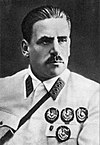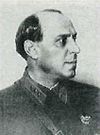Draft:People's Revolutionary Army of the Far Eastern Republic
 | Draft article not currently submitted for review.
This is a draft Articles for creation (AfC) submission. It is not currently pending review. While there are no deadlines, abandoned drafts may be deleted after six months. To edit the draft click on the "Edit" tab at the top of the window. To be accepted, a draft should:
It is strongly discouraged to write about yourself, your business or employer. If you do so, you must declare it. Where to get help
How to improve a draft
You can also browse Wikipedia:Featured articles and Wikipedia:Good articles to find examples of Wikipedia's best writing on topics similar to your proposed article. Improving your odds of a speedy review To improve your odds of a faster review, tag your draft with relevant WikiProject tags using the button below. This will let reviewers know a new draft has been submitted in their area of interest. For instance, if you wrote about a female astronomer, you would want to add the Biography, Astronomy, and Women scientists tags. Editor resources
Last edited by Noahtaylor5042 (talk | contribs) 4 months ago. (Update) |
| People's Revolutionary Army | |
|---|---|
| Народно-революционная армия | |
 | |
| Active | March 1920 – 22 November 1922 |
| Country | |
| Allegiance | |
| Part of | Red Army |
| Garrison/HQ | Vladivostok |
| Engagements | Russian Civil War |
| Insignia | |
| Naval Ensign |  |
The People's Revolutionary Army of the Far Eastern Republic (Russian: Народно-революционная армия Дальневосточной республики) was the armed forces of the Far Eastern Republic, created in March 1920 on the basis of parts of the East Siberian Soviet Army. The commander-in-chief was appointed by the leadership of the RSFSR and was subject to the directives of the Revolutionary Military Council of the RSFSR.
The primary mission assigned to the NRA was the reclamation of the Far Eastern region of Soviet Russia and the elimination of counter-revolutionary White Republics in the Russian Far East and the Amur region.
History[edit]
Operations in Transbaikalia and the Far East (1920-1921)[edit]
In the period of April to May 1920, the NRA conducted two unsuccessful operations in Transbaikalia due to a lack of resources. By the autumn of 1920, diplomatic efforts by the Far Eastern Republic (DVR) successfully led to the withdrawal of Japanese forces from Transbaikalia. The third Chita operation in October 1920 saw the Amur Front forces of the NRA, along with partisans, defeat the White and Cossack forces led by Ataman Grigory Semyonov. This operation resulted in the occupation of Chita on October 22, 1920, and the integration of Transbaikalia into the DVR by early November. Subsequently, the Far Eastern Army and Cossack forces withdrew to Primorye, while Japanese forces evacuated Khabarovsk.
Involvement in Mongolia (1921)[edit]
In the period of May to August 1921, NRA forces, in collaboration with units of the Soviet 5th Separate Army and the Mongolian People's Revolutionary Army, engaged in military actions in Mongolia against White Guard forces commanded by Lieutenant General Roman Ungern von Sternberg. After repelling the White Guard forces in prolonged defensive battles, Soviet forces launched a counteroffensive and successfully defeated them in Mongolia. This operation secured the southern flank of the DVR, and Mongolia was declared the Mongolian People's Republic.
Political Changes and Counter-Offensive (1921-1922)[edit]
On May 26, 1921, with Japanese support, a coup shifted power in Vladivostok and Primorye to a government formed by representatives of the White movement and non-socialist parties. Negotiations between the DVR and Japan did not yield any results. In November 1921, a White counter-army initiated an offensive from Primorye to the north, capturing Khabarovsk on December 22. However, after their advance was halted, they adopted a defensive stance along the Volochaevka-Verkhnespasskaya line, creating a fortified area.
Liberation of Khabarovsk and Conclusion of Civil War (1922)[edit]
A significant turning point occurred on February 5, 1922, when NRA units launched a successful offensive, breaking the enemy's defense by February 12 and ultimately capturing Khabarovsk on February 14.
The culmination of these events unfolded in the Primorsky operation from October 4 to 25, 1922. Repelling the offensive by the White Zemsky army, NRA forces undertook a successful counteroffensive, storming the Spassky fortified area and defeating the main White forces on October 13-14. By October 19, NRA forces reached Vladivostok, compelling the Japanese command to agree to the withdrawal of their troops from the Russian Far East. On October 25, NRA units and partisans entered Vladivostok, marking the conclusion of the operation and the evacuation of remnants of the White forces.
Legacy and Transformation into the Red Army[edit]
By Order No. 653 on November 2, 1922, the People's Revolutionary Army in the Far Eastern Republic formed the Primorsky Corps in the city of Chita.
On November 22, 1922, following the integration of the republic into the RSFSR, the PRA underwent a renaming, becoming the 5th Army of the Red Army and receiving the designation "Red Banner" on July 1, 1923.
Commanders[edit]
Commanders-in-Chief[edit]
| № | Name | Photo | Term start | Term end |
|---|---|---|---|---|
| 1 | Genrich Eiche | March 17, 1920 | January 21, 1921 | |
| — | Sergey Pavlov (Acting) | January 21, 1921 | February 21, 1921 | |
| 1 | Genrich Eiche | February 21, 1921 | April 29, 1921 | |
| 2 | Vasiliy Burov-Petrov | April 30, 1921 | May 4, 1921 | |
| — | Albert Lapin (Acting) | May 4, 1921 | June 25, 1921 | |
| 3 | Vasily Blyukher | 
|
June 26, 1921 | July 14, 1922 |
| 4 | Konstantin Avksentevsky | July 15, 1922 | August 16, 1922 | |
| 5 | Ieronim Uborevich | 
|
August 16, 1922 | November 22, 1922 |
Chief of Defense Staff[edit]
| № | Name | Photo | Term start | Term end |
|---|---|---|---|---|
| 1 | Pyotr Pelenkin | March 18, 1920 | June 29, 1921 | |
| 2 | Vyacheslav Tokarevsky | June 30, 1921 | May 3, 1922 | |
| 3 | Boris Feldman | 
|
May 4, 1922 | July 4, 1922 |
| 4 | Aleksandr Shuvayev | July 4, 1922 | August 21, 1922 | |
| 5 | Ivan Smorodinov | August 22, 1922 | November 22, 1922 |
Minister of War[edit]
| № | Name | Photo | Term start | Term end |
|---|---|---|---|---|
| 1 | Vasily Blyukher | 
|
June 27, 1921 | July 1922 |
